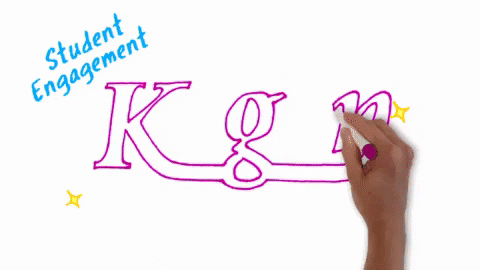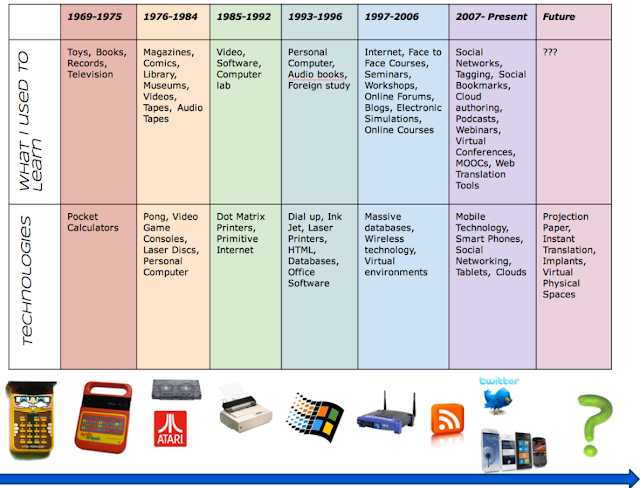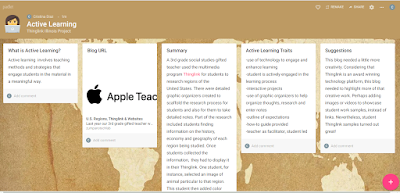Image Source: Natalie Laderas-Kilkenny
The image above is a great example of how education has evolve over time. From the Colonial Era to most recently, there have been major changes in education. Before, the expectation was that students remained seated, in rows, and listened to the teacher lecture a lesson. Then, students began sitting in tables, participated in small group discussion, but mostly had to listen for teacher direction and instruction. Now, with the 21st Century Skills (creativity, critical thinking, collaboration & communication) in place, there has been a huge shift in education. In several places, one might not see students siting in rows, tables or at all. Students will engage more in individualized instruction and work on different skills that others are not necessarily working on. In these learning and innovated spaces we will probably see something similar to the following picture:
Image Source: @ViewSonic
In this image, we see the instructor delivering instruction via a Smartboard or Smart TV. As he guides students through the lesson, students are located in different parts of the room, which is something very different from the traditional setting. Students are actively engaged in the lesson and perhaps learning at their own pace or level. This is part of active learning, which we will learn in the next section.
Active learning involves teaching methods and strategies that engage students in the material in a meaningful way. Students will engage in small group or whole group activities that are centered around writing, listening, speaking, problem solving and reflecting. The following is a great example of some of the strategies that can be implemented to make active learning happen:
In this spectrum of active learning activities, we see the rigor from basic activities that perhaps do not involve so much time, to more rigorous and complex activities. Overall, we see students participating in active learning activities that provide opportunities for learning, applying , synthesizing and getting involved in discussion.
My Experiences with Active Learning

Image Source: Via GIPHY
I currently work in a district that supports Kagan Structures. The Kagan structures include several of the active learning strategies previously mentioned. Some of these are: Think-pair-share, inside-outside circle, all write round robin and several other more. Kagan strategies are part of active learning, as these also follow structures that are different from the traditional instruction. When using Kagan structures, students actively participate and engage in learning. Students end up doing the hard work and the teacher essentially functions as a facilitator.
Through the use of SeeSaw, I would create portfolios for different subject areas. In these portfolios I would add stories, images, videos and student samples to give students the opportunity to access different information. Some of the projects involved working with a partner and having students record about their projects. Students really loved reading my comments or even comments from their parents. SeeSaw gave my students the opportunity to explore a variety of digital tools and enhance their learning.
Exploring Active Learning
This week, I looked at a blog called U.S. Regions, Thinglink and Websites. The blog was originally designed for an elementary school to show the work of a 3rd grade gifted teacher who taught social studies curriculum. In the blog, the teacher shared about the steps students took to research on the region being studied. Students first used a graphic organizer to help them with notes and the things that needed to be displayed in their Thinglink. After students did the research and developed their Thinglink, they had to create a 5 page website. Part of this 5 page website require for students to add all the previous projects they had completed. The use of technology, and specially the Thinglink platform, created a hands on opportunity for students to be actively engage in learning.
Until viewing this blog, I had no idea that such an amazing technology platform like Thinglink existed. The fact that students add their personal touch, have a fun purpose for doing research and showcase their learning in an innovated way makes me want to use this platform right away. If you are as interested as I am in learning and using Thinglink in your classroom or for your teachers, please see the following video:
Video Resource: YouTube
Please checkout the Padlet I created to summarize my learning about the 3rd grade teacher's blog and active learning:
Resources:
Center for Educational Inovation. "Active Learning." Website at https://cei.umn.edu/active-learning
Kagan Structures at https://www.kaganonline.com/about_us.php
Nicole Zumpano (2018). "What is Active Learning." Prezi at https://prezi.com/vltahpm3b1hn/what-is-active-learning/ utm_campaign=share&token=21acedd662237401cb58486f35352d6fba7d05
SeeSaw https://web.seesaw.me/
ThingLink Turotial and How to Use in Classroom Video at https://www.youtube.com/watch?v=1yrcCE4RK1s
ViewSonic Education Blog (2018). "How to Implement Active Learning for Classrooms." Blog at
What is a Padlet? at http://www.wvadulted.org/uploads/4/2/4/9/42499625/padlet_for_beginners.pdf




Hi Cristina! I, too, have used Seesaw a bit when helping out in a kindergarten classroom. I think it is awesome to be able to document what students are doing throughout the day and show parents. It also helps to actively engage parents in the learning that is taking place while their child is at school. Thank you for also sharing this new resource:ThinkLink. This will be a very helpful tool, especially in my science classroom. I could have students use this in order to research and explore a new topic we are learning in class. This could also be used as a differentiation tool because many of my students have different reading levels, or maybe they need to be retaught content in a more interesting way!
ReplyDeleteHi Christine! I can't wait to hear about your science project. I am sure students are going to walk away with a great learning experience. Yes, I did not know that there were so many cool things you could do with Thinglink!
DeleteThis is a great post on active learning. I appreciated the graphics you included and was happy to see you learning about a new tool! Thinglink would be great for your dual-language speakers.
ReplyDelete